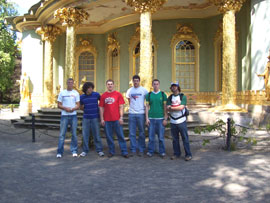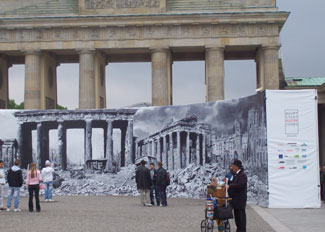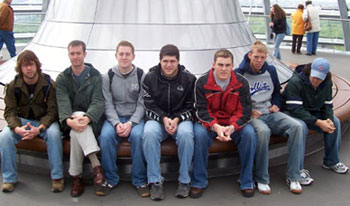Six Wabash students are in Berlin, Germany, until May 20 as part of Professor John Byrne's German 202 class. Students on the trip are corresponding and sending back photos to document their immersion learning experience.
(Received 5/15/05) From Andy Deig:
 Two days ago, we went to a concentration camp in Sachsenhausen. It was not actually an extermination camp, but a forced labor camp. It was very eye opening. Seeing the barracks, the infirmary, the place where executions took place. (See photo album from 5/14 at bottom of page.)
Two days ago, we went to a concentration camp in Sachsenhausen. It was not actually an extermination camp, but a forced labor camp. It was very eye opening. Seeing the barracks, the infirmary, the place where executions took place. (See photo album from 5/14 at bottom of page.)
We found out from looking at a map in one of the musuems that there were actually concentration camps everywhere throughout Germany. There were so many that we couldn't count. There would be a large camp like the ones at Auschwitz or Sachsenhausen and there would be a ton of little camps around there.
Yesterday, we went to the Schloss Sans Sounci (which means the castle of no worries) which was the summer house for Friedrich the Great. There were also many other cool buildings and a beautiful summer garden that we enjoyed. (The photo above are the six Wabash students at one of the castles they visited 5/14.)
After the visit to the castle, we walked through Potsdam, which is an awesome city and enjoyed some of the food there.
Today we saw one of the coolest museums I've ever been to. It was das jüdisches Museum Berlin or the Jewish Museum of Berlin. It was constructed into 3 Axes. The Axis of the Holocaust which led us to a triangular room with huge concrete walls. Once the door to the room was shut, there was no way out. There was a ladder placed high enough on the wall that there is no way any one could get to it. There was not any light except for just a tiny bit at the very top of this tall room. This room represents that there was no way out of the holocaust.
There was almost no light at the end of the tunnel. No one could escape. The second axis was the Axis of the Exiles, and this led us to the Garden of Exiles. It is outside with massive concrete pieces with olive trees growing outside of it. They are all placed in a square. The interesting thing about this is that the garden is built on a tilted surface. So when you walk through, you are constantly off balance and running into the concrete pieces. It almost makes you sick to even walk through it. It is supposed to represent the tough lives of exiles and that there is never any stable ground. The 3rd axis was the Axis of Continuity, and this was the axis for the Jewish people still living. This museum was great!!!
(Received 5/11/05) From Andy Deig:
"After our plane arrived in Berlin and having traveled for almost an entire day, we got right out into the city and explored. We got used to the public transportation system.
"The second day, it rained and hailed, but it did not keep us in. We traveled to das Reichtages Gebäude, but on our way, we passed a very famous structure, the Brandenburger Tur.
 "This was very amazing and one of the reasons why, is because there was a massive mural of the Brandenburger tur directly after the bombings of WWII and it shows the destruction of this monument and the city.
"This was very amazing and one of the reasons why, is because there was a massive mural of the Brandenburger tur directly after the bombings of WWII and it shows the destruction of this monument and the city.
"The Reichtags building was also pretty cool. It showed a panoramic view of every possible angle of Berlin. T-hen we saw the Gedächtniskirche, which is now a historical exhibit of the history of Berlin.
"All of this has been awesome, but one of the best things that has happened to us so far is being able to interact with other Germans. Sometimes, we cannot understand a single word they say, but its great to try. The bars, the pubs, the supermarkets, and the restaurants are all great. The kultur here is amazing and unique. We cannot wait for the rest of this trip to come."
Deig is a Wabash College freshman from Evansville and member of the football team.
(Received 5/11/05) From Tim Rickard:
"My favorite part of today was getting separated from the group and having to find my way back. We were all at a Kaufhaus, and I stayed a little too long while the guys were finding their own way back.
"Discovering I could find my way around Berlin a little bit gives me a little bit more confidence with not only navigating, but also speaking the language. I know I knew enough German that I could survive. I also found that exercising is a great way to get to know the city. I got up at 6:00 and went running. I made a spiral around the Youthhostel and looked and tried to memorize all of the streets. I didn´t memorize them but I do know them when I see them.
"When we went to the Berliner Dom, I heard much of what I learned from the tutorial, which is kind of weird, but just goes to show you how versatile a liberal education is.
"The jury is still out on the application of all the 'victim of wars' instead of 'soldiers of wars' memorials. I guess it is just different than us. Anyway, The trip is going well, and I am hoping that the weather clears up."
Rickard is a Wabash College freshman from Valparaiso and runs track.
 Professor Byrnes is accompanied on the trip by German Instructor Brian Tucker. Students on the trip are Samuel Clark, Andy Deig, Kyle O'Keefe, Matthew Potasnik, Tim Rickard, Kyle Weaver.
Professor Byrnes is accompanied on the trip by German Instructor Brian Tucker. Students on the trip are Samuel Clark, Andy Deig, Kyle O'Keefe, Matthew Potasnik, Tim Rickard, Kyle Weaver.
For more information see: